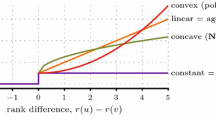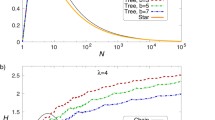Abstract
Many real-world phenomena exhibit strong hierarchical structure. Consequently, in many real-world directed social networks vertices do not play equal role. Instead, vertices form a hierarchy such that the edges appear mainly from upper levels to lower levels. Discovering hierarchies from such graphs is a challenging problem that has gained attention. Formally, given a directed graph, we want to partition vertices into levels such that ideally there are only edges from upper levels to lower levels. From computational point of view, the ideal case is when the underlying directed graph is acyclic. In such case, we can partition the vertices into a hierarchy such that there are only edges from upper levels to lower edges. In practice, graphs are rarely acyclic, hence we need to penalize the edges that violate the hierarchy. One practical approach is agony, where each violating edge is penalized based on the severity of the violation. The fastest algorithm for computing agony requires O(nm 2) time. In the paper we present an algorithm for computing agony that has better theoretical bound, namely O(m 2). We also show that in practice the obtained bound is pessimistic and that we can use our algorithm to compute agony for large datasets. Moreover, our algorithm can be used as any-time algorithm.
Chapter PDF
Similar content being viewed by others
References
Cherkassky, B.V., Goldberg, A.V.: Negative-cycle detection algorithms. In: Díaz, J. (ed.) ESA 1996. LNCS, vol. 1136, pp. 349–363. Springer, Heidelberg (1996)
Clauset, A., Moore, C., Newman, M.E.J.: Hierarchical structure and the prediction of missing links in networks. Nature 453(7191), 98–101 (2008)
Cormen, T.H., Stein, C., Rivest, R.L., Leiserson, C.E.: Introduction to Algorithms. McGraw-Hill Higher Education (2001)
Dinur, I., Safra, S.: On the hardness of approximating vertex cover. Annals of Mathematics 162(1), 439–485 (2005)
Elo, A.E.: The rating of chessplayers, past and present. Arco Pub. (1978)
Even, G., Naor, J.S., Schieber, B., Sudan, M.: Approximating minimum feedback sets and multicuts in directed graphs. Algorithmica 20(2), 151–174 (1998)
Gupte, M., Shankar, P., Li, J., Muthukrishnan, S., Iftode, L.: Finding hierarchy in directed online social networks. In: Proceedings of the 20th International Conference on World Wide Web, pp. 557–566 (2011)
Henderson, K., Gallagher, B., Eliassi-Rad, T., Tong, H., Basu, S., Akoglu, L., Koutra, D., Faloutsos, C., Li, L.: Rolx: Structural role extraction & mining in large graphs. In: Proceedings of the 18th ACM SIGKDD International Conference on Knowledge Discovery and Data Mining, pp. 1231–1239 (2012)
Jameson, K.A., Appleby, M.C., Freeman, L.C.: Finding an appropriate order for a hierarchy based on probabilistic dominance. Animal Behaviour 57, 991–998 (1999)
Macchia, L., Bonchi, F., Gullo, F., Chiarandini, L.: Mining summaries of propagations. In: IEEE 13th International Conference on Data Mining, pp. 498–507 (2013)
Maiya, A.S., Berger-Wolf, T.Y.: Inferring the maximum likelihood hierarchy in social networks. In: Proceedings IEEE CSE 2009, 12th IEEE International Conference on Computational Science and Engineering, pp. 245–250 (2009)
McCallum, A., Wang, X., Corrada-Emmanuel, A.: Topic and role discovery in social networks with experiments on enron and academic email. J. Artif. Int. Res. 30(1), 249–272 (2007)
Papadimitriou, C.H., Steiglitz, K.: Combinatorial Optimization: Algorithms and Complexity. Prentice-Hall, Inc. (1982)
Author information
Authors and Affiliations
Editor information
Editors and Affiliations
Rights and permissions
Copyright information
© 2014 Springer-Verlag Berlin Heidelberg
About this paper
Cite this paper
Tatti, N. (2014). Faster Way to Agony. In: Calders, T., Esposito, F., Hüllermeier, E., Meo, R. (eds) Machine Learning and Knowledge Discovery in Databases. ECML PKDD 2014. Lecture Notes in Computer Science(), vol 8726. Springer, Berlin, Heidelberg. https://doi.org/10.1007/978-3-662-44845-8_11
Download citation
DOI: https://doi.org/10.1007/978-3-662-44845-8_11
Publisher Name: Springer, Berlin, Heidelberg
Print ISBN: 978-3-662-44844-1
Online ISBN: 978-3-662-44845-8
eBook Packages: Computer ScienceComputer Science (R0)




